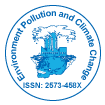The Rising Tide: Understanding and Mitigating Sea Level Rise
Received: 28-Sep-2023 / Manuscript No. EPCC-24-115069 / Editor assigned: 02-Oct-2023 / PreQC No. EPCC-24-115069 (PQ) / Reviewed: 16-Oct-2023 / QC No. EPCC-24-115069 / Revised: 08-Mar-2025 / Manuscript No. EPCC-24-115069 (R) / Published Date: 15-Mar-2025
Abstract
Sea level rise, a consequence of climate change, poses a significant threat to coastal regions worldwide. As global temperatures continue to climb due to the accumulation of greenhouse gases, the melting of glaciers and polar ice caps, and the expansion of seawater, the world's oceans are on the rise. This phenomenon has far-reaching implications for ecosystems, communities, and economies, necessitating urgent attention and concerted efforts for mitigation and adaptation.
Keywords
Sea level rise; Climate change; Glaciers
Introduction
The primary contributor to rising sea levels is the melting of vast ice sheets in Antarctica and Greenland, as well as glaciers in mountainous regions. As these ice masses melt, they release freshwater into the oceans, causing sea levels to increase
Description
Thermal expansion
As the Earth's temperature rises, seawater absorbs heat and expands. This thermal expansion contributes significantly to the observed sea level rise, impacting coastlines across the globe.
Human activities
Anthropogenic activities, such as the burning of fossil fuels and deforestation, contribute to the accumulation of greenhouse gases in the atmosphere. This, in turn, leads to global warming, triggering the melting of ice and the expansion of seawater.
Impacts on coastal regions
Erosion and coastal flooding: Rising sea levels exacerbate coastal erosion, leading to the loss of land and habitat. Coastal communities face increased risks of flooding, particularly during storms and high tides.
Saltwater intrusion: As sea levels rise, saltwater can infiltrate freshwater sources, jeopardizing drinking water supplies and agricultural lands. This phenomenon poses a threat to both human communities and ecosystems.
Loss of biodiversity: Coastal ecosystems, including wetlands and estuaries, are vulnerable to sea level rise. Many species, particularly those with specific habitat requirements, face the risk of displacement or extinction.
Reducing greenhouse gas emissions: Addressing the root cause of sea level rise involves a concerted effort to reduce carbon emissions.
Transitioning to renewable energy sources, improving energy efficiency, and promoting sustainable practices are crucial steps.
Coastal protection measures: Implementing robust coastal protection measures, such as seawalls, levees, and artificial reefs, can help mitigate the impacts of rising sea levels. Nature based solutions, like mangrove restoration and dune stabilization, also play a vital role in safeguarding coastlines.
Urban planning and retreat: Cities and communities in vulnerable areas need adaptive urban planning that considers sea level rise projections. In some cases, strategic retreat and relocation may be necessary to protect lives and infrastructure.
Investing in research and technology: Continued research into climate science, monitoring sea level trends, and developing innovative technologies for climate resilience are essential components of a comprehensive approach to addressing sea level rise.
Conclusion
Sea level rise is a critical consequence of climate change that demands immediate attention and coordinated action. The impacts are multifaceted, affecting ecosystems, communities, and economies. By addressing the root causes, implementing adaptive strategies, and fostering international collaboration, we can strive to mitigate the impacts of rising sea levels and build a more sustainable and resilient future for coastal regions worldwide.
Citation: Hussain S (2025) The Rising Tide: Understanding and Mitigating Sea Level Rise. Environ Pollut Climate Change 9: 428.
Copyright: © 2025 Hussain S. This is an open-access article distributed under the terms of the Creative Commons Attribution License, which permits unrestricted use, distribution and reproduction in any medium, provided the original author and source are credited.
Select your language of interest to view the total content in your interested language
Share This Article
Recommended Journals
Open Access Journals
Article Usage
- Total views: 244
- [From(publication date): 0-0 - Dec 09, 2025]
- Breakdown by view type
- HTML page views: 145
- PDF downloads: 99
